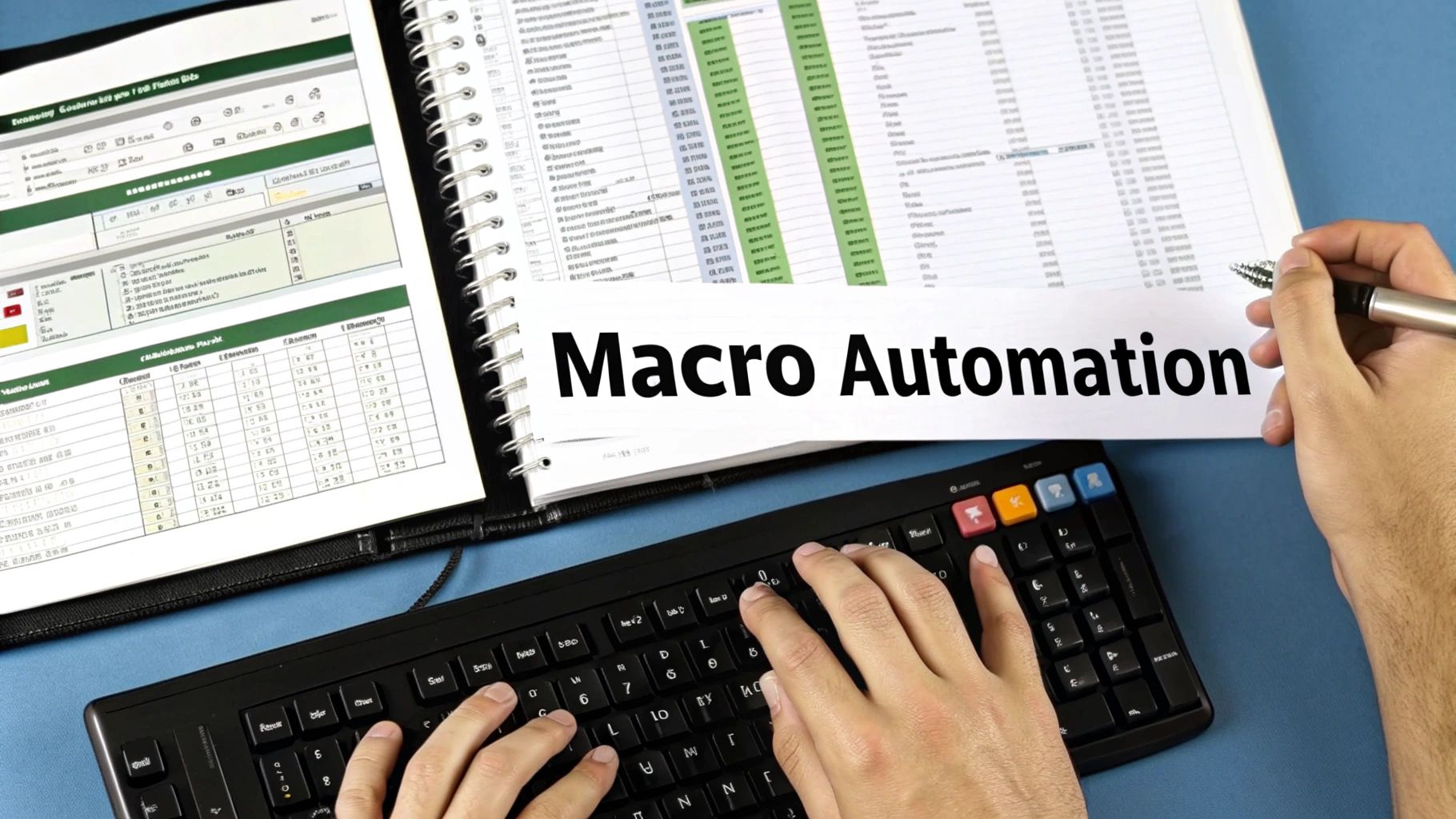
Excel Report Automation: Boost Efficiency & Save Time
Share
The Real Power Behind Excel Report Automation
Excel report automation isn't simply about generating reports more quickly. It's about fundamentally transforming how your team interacts with data. Think of it as an upgrade: instead of walking, you're now driving. Automation empowers your team to analyze larger datasets, uncover more profound insights, and make more informed decisions, impacting everything from daily tasks to long-term strategic planning.
Moving Beyond Manual Processes
Many teams still depend on manual Excel processes, often because change seems daunting. However, these manual methods have a hidden cost. Manual data entry is susceptible to human error, and repetitive tasks consume valuable time that could be used for analysis and interpretation. To break free from these limitations, teams need to recognize the potential of automation and embrace new ways of working. This could involve simple macros or more complex VBA scripts, tailored to specific needs.
The Tangible Benefits of Automation
The contrast between manual reporting and automated workflows is striking. Automated reports are created instantly, saving hours of tedious work. Data accuracy significantly improves, minimizing the risk of costly mistakes. Moreover, automation liberates your team to concentrate on high-value tasks, such as strategic analysis and decision-making. This facilitates deeper insights and proactive responses to evolving market conditions. For instance, rather than manually compiling sales data, your team could automate reports and focus on identifying market trends and developing sales strategies. You might be interested in learning more about Excel automation: How to master...
Excel: Still a Powerful Tool
Despite the emergence of modern business intelligence tools, Excel remains a cornerstone for many organizations. As of 2025, 58% of finance leaders still depend on Excel as their primary technology, demonstrating its continued relevance in managing business operations. This widespread use highlights the familiarity and flexibility Excel offers. Discover more about Excel usage in finance. This continued reliance makes Excel report automation even more vital, allowing businesses to maximize the value of this familiar tool while overcoming its inherent limitations. This understanding is key to harnessing the real power of Excel report automation and how it can transform your workflows.
Breaking Free From Excel Reporting Bottlenecks
The infographic above illustrates the power of Excel report automation. The image of organized spreadsheets and formulas, coupled with the phrase "Boost Efficiency," visually represents the core advantage of automation: streamlining data processes for increased productivity. It emphasizes the shift from manual tasks to a more efficient, automated approach.
Spending hours manually updating Excel reports, hunting for errors, and recreating the same charts every month is a common source of frustration. This repetitive process creates reporting bottlenecks, impacting productivity and delaying important business decisions. Fortunately, there's a better way. This section explores the challenges faced by Excel-dependent teams and presents effective automation solutions.
Identifying Automation Opportunities
The first step to eliminating reporting bottlenecks is identifying areas where automation can have the biggest impact. Time-consuming tasks are often the best candidates. Consider reports that involve consolidating data from multiple sources, complex calculations, or frequent updates. These are prime areas where Excel report automation can significantly boost efficiency.
Automating data validation checks also minimizes errors and improves accuracy, saving time and resources in the long run. This proactive approach to data quality ensures that reports are reliable and based on accurate information, further enhancing the value of automation.
According to Forrester, a staggering 82% of organizations still rely on manual routing of tasks often supported by Excel, a process known for being time-consuming and prone to inaccuracies. This reliance highlights the need for efficient Excel report automation solutions. For more insights on this, check out these business process automation statistics. Document Workflow Automation can also play a vital role in streamlining operations.
To better illustrate the differences between manual and automated reporting, let's look at a comparison table. This table outlines the key distinctions and potential improvements automation can offer.
Manual vs. Automated Excel Reporting Comparison A detailed comparison of traditional manual Excel reporting processes versus automated solutions across key performance metrics
| Process Aspect | Manual Excel Reporting | Automated Excel Reporting | Improvement Potential |
|---|---|---|---|
| Data Entry | Manual, prone to errors | Automated, reduced errors | Significant reduction in errors and increased accuracy |
| Data Consolidation | Time-consuming, manual merging | Automated, data integration from various sources | Substantial time savings and improved data consistency |
| Report Generation | Manual creation, formatting, and distribution | Automated generation, customizable templates, scheduled delivery | Increased efficiency and faster reporting cycles |
| Error Checking | Manual review, prone to oversight | Automated validation rules and checks | Improved data accuracy and reduced risk of errors |
| Report Updates | Manual updates, repetitive work | Automated updates, real-time data refresh | Significant time savings and improved data currency |
As you can see, automating Excel reporting offers numerous benefits across various aspects of the reporting process. The potential for improved accuracy, time savings, and efficiency is substantial.
Transforming Workflows with Automation
Real-world case studies show how organizations have successfully transformed their reporting processes with Excel report automation. Analyzing before-and-after scenarios across different industries reveals the specific automation techniques that yield the most significant time savings. These examples demonstrate the tangible benefits of automation, from reduced error rates to increased productivity. For more in-depth examples, you might find this helpful: How to master...
Overcoming Resistance to Change
A key challenge in implementing Excel report automation is resistance to change. Many people are comfortable with familiar processes, even if inefficient. Addressing these concerns and highlighting automation's benefits for both individuals and the organization is crucial.
By emphasizing the positive impact on productivity, job satisfaction, and overall business performance, you can effectively overcome resistance and create a more streamlined reporting process. This sets the stage for identifying high-value automation opportunities and empowering your team to embrace positive change. This understanding is essential for successfully implementing and benefiting from Excel report automation.
Essential Tools That Transform Excel Reporting

Beyond the basics of formulas and functions, Excel boasts a powerful toolkit designed to automate reporting. Many users stick with manual methods, unaware of these time-saving features. This section explores Excel's most useful tools and helps you choose the right one for your reporting needs.
Harnessing the Power of Power Query
Power Query, a data connection and transformation tool within Excel, can significantly improve your reporting efficiency. It connects to various data sources like databases, web pages, and files. You can then clean, transform, and reshape data without complex formulas.
Think of tasks like removing duplicates, pivoting data, and creating calculated columns. Power Query handles these within a user-friendly interface. This streamlines data preparation, a key step in Excel report automation, saving you time and effort.
Dynamic Modeling with Power Pivot
Power Pivot extends Excel's data modeling capabilities. It handles large datasets and complex relationships, enabling advanced analysis and dynamic reports that adapt to changing business needs.
Imagine analyzing sales by region, product, and time period. Power Pivot allows you to create interactive reports that offer valuable insights, pushing Excel report automation beyond basic reporting tasks.
VBA: Customizing Your Automation
While Power Query and Power Pivot offer substantial automation, Visual Basic for Applications (VBA) allows for fully customized solutions. VBA lets you write code to automate tasks, from generating reports to sending email notifications.
There is a learning curve with VBA, but the flexibility for tackling complex automation challenges is immense. For more information, you might be interested in: How to master...
Choosing the Right Tool for the Job
Effective Excel report automation depends on understanding when to use built-in features versus VBA. For simple tasks like data cleaning, Power Query is often the quickest solution. However, for more complex scenarios requiring custom logic, VBA might be necessary. Combining these tools can maximize their impact, creating comprehensive and dynamic reporting systems.
Balancing Quick Wins and Long-Term Value
Different tools offer varying returns on investment (ROI) for Excel report automation. Power Query offers quick wins by streamlining common data tasks. VBA requires more upfront learning but offers greater long-term value through customized solutions. Consider both the learning curve and long-term benefits when choosing your tools.
Practical Implementation Guidance
New to automation? Here's a breakdown of common tasks and how to approach them:
- Data Consolidation: Use Power Query to connect and combine data from various sources.
- Report Generation: Use built-in Excel features or VBA for custom reports.
- Data Validation: Implement VBA code to automatically validate data and flag errors.
- Report Distribution: Automate report distribution via email using VBA.
Streamlining Business Processes with Automation
These tools and strategies can streamline functions across departments. Finance teams can automate financial statements, sales teams can automate performance reports, and operations teams can automate inventory reports. This frees up time for analysis and decision-making, leading to improved efficiency and better outcomes.
By understanding and strategically applying these tools, you can transform your Excel reporting, unlocking new levels of efficiency and insight. This empowers you to move beyond manual tasks, focusing on higher-value activities that drive business success and build a robust Excel report automation system.
Your First Excel Report Automation: A Practical Guide

This section offers a practical walkthrough for automating your first Excel report. We'll break down the process into clear, actionable steps, from identifying which reports are best suited for automation to implementing and testing your solution. This guide will help you achieve meaningful results quickly, no matter your technical skill level.
Identifying Automation Candidates
The first step in Excel report automation is pinpointing the right reports. Target reports you generate frequently, especially those that demand significant manual work. Weekly sales summaries, monthly financial dashboards, or quarterly performance reviews are all excellent examples.
Prioritize reports involving complex formulas or data manipulation. Automating these tasks minimizes errors and frees your time for more strategic activities. This shift allows you to focus on analyzing the data, not just compiling it.
Planning Your Automation Strategy
After selecting a report, plan your automation strategy. What specific tasks are you automating? Will you utilize built-in Excel functions, Power Query, or VBA? Defining your goals and selecting the right tools will streamline implementation.
Consider your data sources. Are you pulling data from multiple spreadsheets, databases, or online services? Power Query excels at consolidating data from various sources, making it a potent tool for Excel report automation.
Implementing Your Automation Solution
Start by dividing the report creation process into smaller, manageable steps. This might involve importing data, performing calculations, creating charts, and formatting the final report. Then, automate each step using your chosen tool.
For example, to automate a sales report, you could use Power Query to import data from a CRM system. Then, leverage built-in Excel functions or VBA to calculate totals and generate charts. For additional guidance, consider resources like How to master....
Testing and Refining Your Automated Report
Thorough testing is crucial after implementing your Excel report automation solution. Verify that the automated report delivers accurate results and matches the format of your manually created report. This validation ensures the reliability of your automated process.
Documenting your automation process is essential for future reference and maintenance. This documentation becomes invaluable for troubleshooting or modifying the process as your reporting needs evolve.
Examples of Commonly Automated Reports
Many reports benefit from automation. Financial dashboards can be automated to update key metrics in real time. Sales analytics reports can automatically track performance and highlight trends. Operational metrics reports can monitor efficiency and flag potential problems.
While Excel is a powerful reporting tool, consider dedicated software like Inventory Management Software for businesses with complex data needs. By automating these reports, businesses gain valuable insights and make data-driven decisions more efficiently. The global AI and automation software market is expected to experience substantial CAGR from 2025 to 2033, as shown here. This growth underscores the increasing recognition of automation’s potential to transform business processes and boost efficiency. This practical guide provides a strong foundation for your Excel report automation journey, enabling you to reach new levels of efficiency and insight.
Taking Excel Report Automation to the Next Level
Ready to move beyond the basics of Excel report automation? This section delves into advanced techniques that can yield exceptional results. We'll explore how top-performing organizations use advanced VBA programming, API integrations, and intelligent distribution systems to transform their reporting processes. This goes beyond simple macros and taps into Excel's full potential as a powerful automation platform.
Advanced VBA Programming for Complex Automation
Basic VBA can automate simple tasks, but advanced VBA unlocks far greater power for Excel report automation. By using custom functions, user forms, and event handling, you can create dynamic and responsive reports. Imagine reports that automatically update based on user input or changes in external data sources. While this level of automation requires deeper VBA knowledge, the benefits are substantial.
For example, consider automating a complex financial report. This might involve consolidating data from numerous sources, performing complex calculations, and generating dynamic charts. Advanced VBA empowers you to build a solution tailored to these specific needs. Learn more in our article about How to master...
Seamless API Integrations
Integrating Excel with external systems through APIs takes automation even further. Think about connecting your reports directly to databases, cloud services, or other business applications. This allows for real-time data updates and eliminates manual data entry.
This approach creates a truly dynamic reporting environment. Your Excel reports become living documents, constantly reflecting the most current information. This level of integration can fundamentally change how your organization leverages data for informed decision-making.
Intelligent Distribution Systems
Automated reports require efficient distribution. Instead of manually emailing reports, consider implementing automated distribution systems. These systems can deliver reports to designated recipients on a pre-set schedule, ensuring timely delivery of information to the right people. This streamlines communication and minimizes the risk of errors. Furthermore, reports can be customized for each recipient, providing targeted information based on individual needs.
Building Self-Maintaining Dashboards
The ultimate goal of advanced Excel report automation is to create self-maintaining dashboards. These dashboards update automatically, minimizing manual intervention. This allows your team to focus on analysis and insights rather than time-consuming updates, shifting the focus from data compilation to data interpretation.
Implementing Governance Frameworks
As automation solutions increase in complexity, governance becomes crucial. Establish clear guidelines for development, documentation, and maintenance. This ensures the long-term reliability and sustainability of your automated reports, even as teams and business needs evolve. A robust governance framework provides the foundation for sustained success in Excel report automation.
To illustrate the potential ROI of Excel report automation, let's examine some key statistics. The table below showcases the impact of automation on businesses of different sizes.
Excel Report Automation ROI Statistics
| Business Size | Time Saved (hours/month) | Error Reduction (%) | Cost Savings ($) | Implementation Timeline |
|---|---|---|---|---|
| Small | 20 | 15 | 1000 | 1 month |
| Medium | 50 | 25 | 5000 | 2 months |
| Large | 100 | 40 | 10000 | 3 months |
As you can see, automating Excel reports offers significant benefits across various business sizes, including substantial time savings, reduced errors, and considerable cost savings. Implementing these strategies can significantly enhance your reporting efficiency and accuracy.
Beyond Excel: Future-Proofing Your Automation Strategy
While Excel report automation offers immediate advantages, organizations looking ahead understand the need for a sustainable, long-term strategy. This means integrating Excel with larger enterprise systems and exploring how new technologies can improve automation capabilities. This section explains how to create automation solutions that adapt to changing business needs and technological progress.
Integrating Excel with Enterprise Systems
Connecting Excel with your enterprise systems opens up significant opportunities for Excel report automation. Integrating with Business Intelligence (BI) platforms, such as Power BI, allows you to use robust data visualization and analysis tools. Connecting with Enterprise Resource Planning (ERP) systems provides direct access to important operational data. This integration simplifies data flow and reduces manual data transfers, improving both efficiency and accuracy.
For instance, integrating Excel with a BI platform like Power BI lets you build interactive dashboards that pull data directly from your ERP system. This dynamic method empowers you to track key metrics in real time and get deeper insights into your business operations.
Practical Approaches to System Integration
There are several ways to integrate Excel with other systems. Power Query provides a user-friendly interface to connect to different data sources, including databases and web services. For more complex integrations, APIs offer greater flexibility and control over data exchange. The best approach depends on your specific integration requirements and technical skills.
The Role of AI in Excel Automation
AI is quickly changing Excel report automation. AI-powered features can automate tasks like data cleaning, analysis, and even report creation. These tools can significantly decrease manual work and allow your team to concentrate on more strategic activities. This creates new opportunities for more advanced and insightful reporting.
Deciding When to Extend vs. Transition
Knowing when to continue using Excel and when to switch to a specialized platform is a crucial strategic decision. For organizations that rely heavily on Excel, expanding its automation features through integrations and AI may be the most practical first step. However, as data volume and complexity increase, transitioning to a dedicated BI platform might become necessary for optimal performance and scalability. Carefully assessing your current requirements and future growth plans will guide this choice.
This forward-thinking approach to Excel report automation makes sure your investments deliver long-term value, preparing your organization for continued success in a constantly changing data environment.
Ready to boost your spreadsheets and showcase your Excel expertise? Visit SumproductAddict for a unique selection of Excel-themed apparel and office accessories! From clever t-shirts to useful desk mats, we have everything you need to express your appreciation for spreadsheets. Use code FIRST10 for a 10% discount on your first purchase!